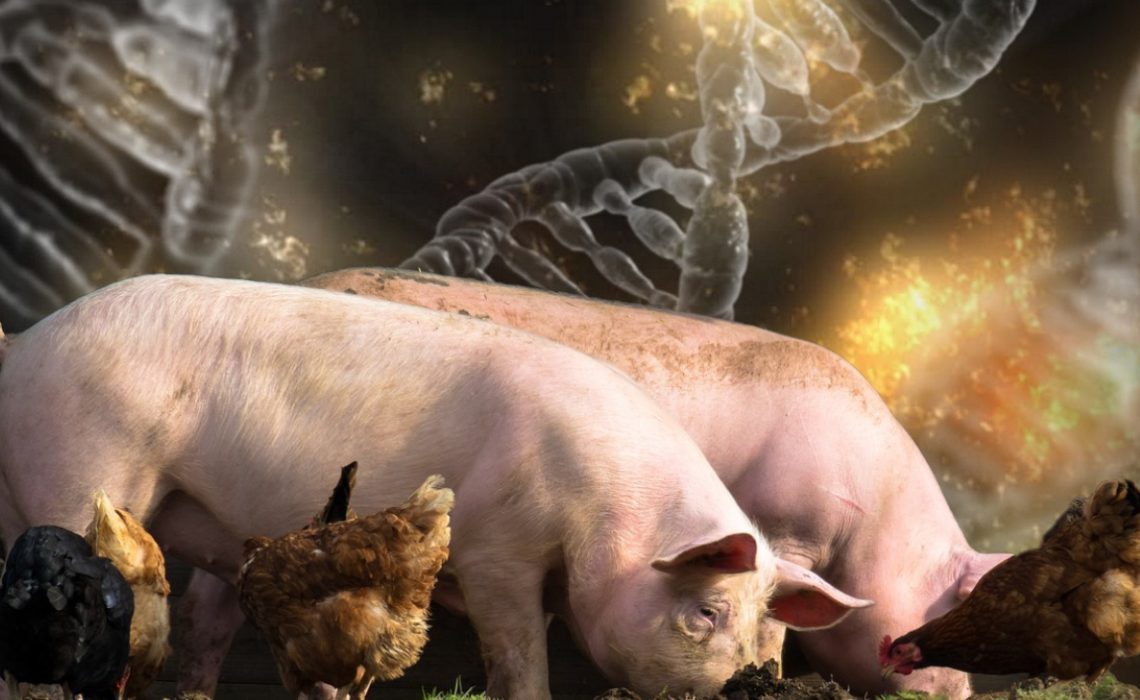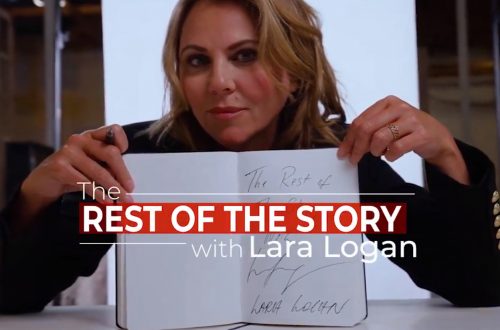10 Things You Need to Know About DNA & RNA Vaccines for Livestock

By The Sharp Edge
1. What are the different terms used for DNA or RNA-based veterinary biologics?
Not all genetic technologies used in veterinary medicine fall under the categories of “mRNA vaccines” or “mRNA gene therapies.” There are other terms to look out for when it comes to genetic technologies for veterinary medicine. These terms also include:
- “RNA Particle Technology”
- “RNA Particle Platform”
- “DNA Vaccine”
- “DNA Immunostimulant”
- “Prescription Platform Product”
2. How do DNA or RNA-based veterinary biologics work?
With SEQUIVITY’s RNA Particle Technology, a “gene of interest provides instructions” to the immune cells which “translate the sequence into proteins” that “act as antigens.” This triggers an immune response.
As for AgriLab’s ExactVac DNA technology, “the vaccine is produced by splicing a gene for a specific antigen” into “a bacterial plasmid” which “is then multiplied, purified and administered” for “delivery into target cells, where antigens produced by the plasmid elicit an immune response.”
Bayer’s Zelnate DNA immunostimulant is “made up of a special type of immunostimulatory DNA surrounded by a lipid carrier or liposome” which is then “engulfed by the animal’s immune cell” where the “liposome breaks down exposing the DNA” and the “pathogen-associated molecular pattern” of the DNA “attaches to the immune cell’s toll-like receptors triggering activation of the immune cell.”
3. Which agency approves veterinary biologics?
The USDA’s Animal and Plant Health Inspection Service (APHIS) and their Center for Veterinary Biologics is responsible for approving veterinary biological products including vaccines and DNA or RNA-based biologics. Here are the lists of the currently licensed veterinary biological products and biologics for aquatic animals.
4. Which DNA or RNA-based biologics have been approved for food animals?
There are several DNA and RNA-based genetic technologies that have received USDA approval or conditional approval for use on chickens, cows, fish, and pigs as outlined below.
Chickens
- In September 2015, Harrisvaccines received a USDA conditional license for an RNA-based avian influenza vaccine. Harrisvaccines “employs their unique SirraVaxSM RNA Particle (RP) technology platform” which can be updated to match current and future avian flu strains. In October 2015, Harrisvaccines was awarded a USDA stockpile contract of 48 million doses of their “pioneering RNA particle vaccine.” In November 2015, Merck acquired Harrisvaccines.
- In November 2017, AgriLabs received USDA conditional approval for “the first DNA vaccine ever licensed for chickens” for avian flu using “AgriLabs’ ExactVac DNA technology with ENABL adjuvant.” In January 2018, Huvepharma acquired AgriLabs. Huvepharma’s DNA-based avian influenza vaccine has a conditional license on APHIS’s most recent list of approved veterinary biological products.
Cows
- Bayer’s Zelnate DNA Immunostimulant received USDA approval for use against bovine respiratory disease (BRD) in January 2014. Zelnate is the “first-of-its-kind” DNA immunostimulant that is a genetic technology rather than a vaccine or antibiotic. Bayer’s DNA immunostimulant is on APHIS’s most recent list of approved veterinary biological products.
Fish
- Elanco’s Apex IHN DNA vaccine for salmonids against Infectious Hematopoietic Necrosis Virus (IHNV) has received USDA approval and is on APHIS’s most recent list of licensed biologics for aquatic animals. Elanco’s DNA technology uses “relevant genetic components of the virus” that are inserted into a plasmid and injected into the muscle, after which the plasmid “instructs cells to produce antigens, which initiate an immune response.”
Pigs
- In June 2014, Harrisvaccines became the first in the nation to receive USDA conditional licensing for their RNA-based PEDv vaccine for pigs. In November 2015, Merck acquired Harrisvaccines. Merck’s “RNA particle platform” for Coronavirus and Porcine Epidemic Diarrhea Vaccine (PEDv) has conditional approval by the USDA and this product has conditional licensing on APHIS’s most recent list of veterinary biological products.
- In December 2017, AgriLabs received USDA approval for a DNA-based swine flu vaccine. In January 2018, Huvepharma acquired AgriLabs. Huvepharma’s ExactVac DNA-based swine flu vaccine is on APHIS’s most recent list of approved veterinary biological products.
- In 2020, Huvepharma’s DNA-based vaccine platform for pigs received USDA approval as a “prescription platform product” so that the “manufacturer may update the gene insert in this vaccine under expedited procedures to respond to emerging needs.” Huvepharma’s DNA-based swine vaccine platform has conditional licensing as a prescription product on APHIS’s most recent list of approved veterinary biological products.
- In 2020 and 2021, Merck’s Sequivity RNA vaccines for strains of swine influenza, which use “RNA particle technology,” were approved by the USDA and are on APHIS’s most recent list of approved veterinary biological products.
- Also in 2021, Merck’s RNA particle technology, for use as a “prescription platform product,” was conditionally approved by the USDA and has conditional licensing on APHIS’s most recent list of veterinary biological products.
5. Is there ongoing research into DNA or RNA-based veterinary biologics?
There are a number of ongoing studies on DNA and RNA-based genetic technologies for veterinary medicine, as outlined below.
- Bayer Partners with BioNTech to Develop mRNA Vaccines, Drugs for Animal Health, May 2016
- Development of a Self-amplifying mRNA Vaccine for African Swine Fever and Classical Swine Fever, Start Date: Jun 1, 2021, End Date: May 31, 2024
- Development of mRNA-based Vaccines for Heterosubtypic Protection Against Infectious Bronchitis and Infectious Laryngotracheitis Viruses, Start Date: Oct 1, 2021, End Date: Sep 30, 2023
- mRNA Vaccine Development for Emerging Animal and Zoonotic Diseases, February 2022
- Novel mRNA Vaccine Technology for Prevention of Bovine Respiratory Syncytial Virus, Start Date Oct 1, 2021, End Date Sep 30, 2026
- Novel Vaccine Technologies in Veterinary Medicine: A Herald to Human Medicine Vaccines, April 2021
- Vaccines to Reduce Salmonella Infantis in Chickens, Start Date: Sep 1, 2022, End Date: Oct 1, 2024
6. Is it possible for mRNA vaccines in livestock to contaminate meat, dairy or egg products?
According to a recent Epoch Times report, a 2014 USDA presentation on Vaccination for Contagious Diseases states that food animals receiving vaccines are subject to “mandatory withdrawal periods prior to slaughter for human consumption. Animals may not be sent to market until the withdrawal time has elapsed. During the mandatory withdrawal time vaccinated animals or products from vaccinated animals may not enter the food chain. The withdrawal time is determined by the country in which the vaccine is licensed and stated in the product license.” As the Epoch Times report notes, the USDA recognizes that there must be a waiting time between vaccination and slaughter for human consumption due to risks of contaminating the food supply. The USDA presentation does not, however, acknowledge DNA or RNA-based biologics, but the same standard of waiting times likely applies, as evidenced by Merck’s RNA vaccine for pigs, which states “Do not vaccinate within 21 days before slaughter.” However, Dr. Peter McCullough notes that mRNA technology “is far more durable than we ever could’ve imagined. It lasts in the human body for months unchanged.” Therefore, even with standard wait times, Dr. McCullough believes it is conceivable that mRNA technology administered to food animals could contaminate the food supply.
With that said, the Epoch Times report found “zero peer-reviewed studies looking into the transmissibility of mRNA vaccines from livestock to humans via either milk or meat.” Dr. Peter McCullough has warned that developers of novel vaccine technologies for veterinary medicine are “blinded with infatuation for molecular biology and have lost sight of biological product safety in the food supply” adding that they have failed to acknowledge the “possibility of collateral impact to humans.” In addition, Dr. McCullough has raised concerns regarding transmissibility based on a recent study which loaded cow’s milk with mRNA, and by consuming the milk, mice were successfully administered a Covid vaccine. Dr. McCullough points out the “considerable ethical issues” this research presents, with a large segment of the public having “strong objections to mRNA in the food supply, particularly if it was done surreptitiously or with minimal labelling/warnings.”
7. Are there labeling requirements for meats, dairy or eggs that may have been contaminated by DNA or RNA-based veterinary biologics?
The required labeling for meat, dairy and egg products is not transparent about possible exposure to DNA or RNA-based veterinary biologics. The USDA does, however, require “Bioengineered” labeling for foods that “contain detectable genetic material that has been modified through certain lab techniques and cannot be created through conventional breeding or found in nature.” It is unclear whether the USDA’s testing process for “detectable genetic material” is capable of picking up traces of genetic material from biologics used in veterinary medicine.
Moreover, the USDA’s “Organic” labeling does appear to permit vaccines for livestock used for meat, dairy and eggs, though the requirements state that animals must not be given hormones or antibiotics. A 2013 Agricultural Marketing Service document states that “organic livestock must be: – Produced without genetic engineering.” However, the same document goes on to say that “Only a few drugs, such as vaccines, are allowed” for organically raised livestock.
Furthermore, in many cases, labeling is not clear about the country from which meats originate. Country of Origin Labeling (COOL) requirements were dropped for beef and pork in 2016. COOL requirements remain in place for lamb, goat, chicken, and fish. Additionally, USDA regulations on meat, poultry and eggs have enabled “Product of USA” labeling for animals born and raised in other countries and only processed in the U.S. However, in March 2023, the USDA proposed a new rule to restrict labeling for “Product of USA” or “Made in the USA” to be used on “meat, poultry and egg products only when they are derived from animals born, raised, slaughtered and processed in the United States.”
8. Which organizations are behind this agenda?
According to a Corey’s Digs report, Codex Alimentarius was established by the UN’s Food and Agriculture Organization (FAO) and the WHO, for “the sole purpose of setting the standards and guidelines for all food that is consumed by human beings.” The report states that Codex does not have the authority to make laws, “so the 189 country members, 20 of which are heads of the various committees, take these ‘standards’ and create regulations and laws in their respective country. The USDA, for example, is a driving force for not only adhering to the standards, but making certain other countries follow in lock step as well.” Codex Alimentarius plays “a key role” in the implementation of new technologies within food standards, including “genetic editing” and “nanotechnology applications in the food sector” as well as “alternative food proteins.”
9. What are lawmakers, producers and concerned citizens doing to protect against contamination of the food supply from mRNA vaccines?
Lawmakers have proposed legislation in Arizona, Idaho, Missouri, South Carolina, Tennessee, and Texas to prohibit mRNA in meats or to require disclosure in food labeling. While legislation in Missouri and Idaho failed, efforts to block mRNA vaccines in livestock remain ongoing in other states.
A trade group, known as The Beef Initiative, has pledged that their Beef Box producers will not “use any mRNA vaccines in their livestock.” Over 100 producers are partnered with The Beef Initiative and can be found here.
Attorney Tom Renz has spearheaded the movement by states for transparency and disclosure of mRNA gene therapies in the food supply. Renz helped to draft Missouri’s HB1169. Naomi Wolf of Daily Clout is also promoting the cause. Doctor Peter McCullough has raised awareness on the issue of genetic technologies used in veterinary medicine and the potential dangers to the food supply in recent interviews and on substack publications.
10. What can the public do about it?
Stay informed and inform others by sharing this information. Additional resources on this topic are listed below. Support lawmakers and advocacy groups pushing for transparency and blocking DNA or RNA-based biologics from entering the food supply. Know what’s in your food and who is producing it. Buy from producers that have pledged to never use DNA or RNA-based genetic technologies, such as The Beef Initiative. Corey’s Digs has also published an excellent resource for finding high-quality foods as well as an incredible source for US Prime and High Choice Beef.
Additional Resources:
Chinese Load Cow’s Milk with mRNA Exosomes – Successfully Immunize Mice – Dr. Peter McCullough
Covid Vaccines ‘Opened the Floodgates’ for New Wave of mRNA Vaccines for Livestock – The Defender
Data on miRNA Transfer from Food into Human Body are Inconclusive, New Concerns of Genetic Material in Food Supply Spur Review of Research on Transmission – Dr. Peter McCullough
Eat Your Vaccines!… I Mean Vegetables! – Tom Renz
Eat Your Vaccines: mRNA Gene Therapy is Coming to the Food Supply THIS MONTH – Daily Clout
Finding Sources of Fresh Food – Corey’s Digs
Funding the Control Grid Part 3: The Food Framework – Corey’s Digs
Inside Codex with Scott Tips: New Global Food Diet – Insects, Rats and Dogs – Corey’s Digs
“Pharma Food” with Elze van Hamelen – Corey’s Digs
Novel Vaccine Technologies in Veterinary Medicine: A Herald to Human Medicine Vaccines, Explosion of Genetic Vaccines in Animals Gets Human Attention – Dr. Peter McCullough
The Shocking Truth About Edible mRNA Vaccines in Our Food (Part 2) – Epoch Times


Subscribe to Corey’s Digs so you don’t miss a Dig!











7 Comments
Leslie
You know, my son just came off life support, he’s 38, and I just found out he’s had at least 3 blood transfusions and more are coming! I expressed my utter concern for mRNA vaccinated blood, (he chose not to be vaxxed) and the dr said they don’t know if the donated blood is vaxxef or not! 😳 it’s a privacy thing!!!!!! 🤨That is horrible, that vac privacy shouldn’t be! So much for concent, now I will assume he’s been vaccinated by this tainted blood! I offered to donate my blood for future use they said we don’t use the families blood!? Anyhow, their polluting us every way they can! Even when supposedly saving lives! A new waiting came! 😕
Dustmagnet
Thank you so much for this work. I have strong concerns about these experimental vaccines and have been trying to raise awareness of this practice. This article, with its links, is invaluable. Please keep on top of this.
Also, I have seen concerns about the possibility of these vaccines being developed for household pets, horses, etc. This also needs to be explored.
No rational person would want to be exposed to animals or food sources with inadequately tested vaccines administered.
Elaine Biggerstaff
I believe we can be certain that all “vaccines” will use mNRA from now on as their plan to depopulate the world has yet to reach the number they want. Our food supply has already been toxic for decades making us sicker than we have ever been.
Thank you Corey for the effort and time you have put into documenting and explaining fully how the criminals are working to exterminate human beings.
Julie
Yes, I wonder about pets. I just got a kitten that had one kitten shot before I got her, She had a visible hard flesh lump at the injection site. Soon I found another just like it on her neck, then more appeared on her head and neck. The previous owners said she had no lumps before the injection. So what’s in pet vaccines that do things like this to pets? The lumps fall off and then reappear smaller and smaller. I think they are gradually disappearing but I had cats all my life and never saw anything like this.
Christie
Soo very grateful for your work. Please keep it up! Wow. I will never eat out again.
It’s bad enough out spinach is being grown with experimental tracking devices, developed in my backyard at Livermore Labs.
What else is going on with our food and water that we don’t yet know about!?
We need to raise our own animals and grow everything. Wow.
Pamm Larry
I did not see any reference to Mark Kastel’s paper on this subject. He used to work with Cornucopia as a watchdog of the organic industry. He was too critcal of the organic industry to stay there so formed Organic Eye. In my work with the GMO free movement and going to many NOSB meetings, Mark and his crew were always of the highest integrity. He’s the one I full trust on organic purity.
https://organiceye.org/wp-content/uploads/2023/07/Vaccines-in-Organic-Livestock-Production-JUNE2023-V12.pdf
Natasha
Corey, this was written in 2023. It’s 2025. We need an update desperately, please and thank you!